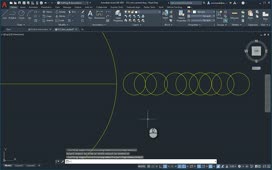Changing Dimensional Constraints Using Grip Editing
In addition to updating constrained objects by changing the values of constraint variables, you can also use grip editing to modify the size of dimensional constraints.
For example, when you select the d2 aligned constraint, you see triangular grips. You can then click and drag the grips to change the length of this constraint. Click and drag the upper grip. The object immediately updates, just as it would if you had changed the value of the d2 constraint. Press ESC to deselect the constraint.
Similarly, when you select the ang1 angular dimensional constraint, you can change the angle of the part by dragging either of the triangular grips. Press ESC to deselect the constraint.
Select the d2 constraint again and then click and drag the square grip to move the linear constraint. Dynamic dimensional constraints are more limited than annotational dimensional constraints in where the text can be located.
Select the rad4 constraint. In this case, you do not see any triangular grips. This is because triangular grips are not available for dimensional constraints that reference other constraint variables in expressions.
There are also two ways to cancel the effects of constraints when you need to make design changes: you can delete the constraints individually and later apply new constraints, or you can relax the constraints temporarily on selected objects to make the changes.
For example, to relax the rad3 constraint, select it and then click the triangular grip. A dynamic menu tooltip appears explaining that you can press the SHIFT key to cycle between maintaining constraints and relaxing constraints. Press SHIFT and then drag the grip.
A dialog box appears, telling you that a dimensional constraint or user variable with an expression has been set to a numerical value. When relaxing constrained geometry, dimensional constraints with expressions or parameters that reference relaxed constraints may be set to numerical values. Click OK.
Relaxed constraints are not maintained during editing. Constraints are restored automatically if possible when the editing process is complete. Note that rad4 is no longer equal to the formula rad3+0.25. Instead, rad4 has been set to a numerical value.
If you make changes that result in some constraints no longer being valid, AutoCAD displays a warning to tell you that constraints that are no longer valid have been removed. You may then need to edit your drawing to restore its design intent.
Source: Autodesk




